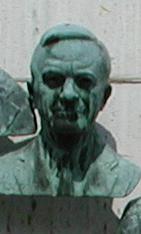Charles Armstrong (physician)
Charles Armstrong ( born September 25, 1886 in Alliance ( Ohio), † June 23, 1967 in Bethesda ( Maryland)) was an American physician and virologist in the American health care system. He coined the name Lymphocytic choriomeningitis 1934 (LCM ), after the hitherto completely unknown LCM virus isolated. He discovered in 1939 that polio virus to cotton rats can be transferred, and began self-test with nasal spray vaccinations.
Academic Career
After graduating from high school in his birthplace Alliance Armstrong first attended the Mount Union College Preparatory School from 1905 to 1906 and then the Mount Union College, where he graduated in 1910 with a Bachelor of Science degree. In 1915 he received his doctorate at Johns Hopkins Medical School, the MD and completed to 1916 a year as an assistant physician at Yale - New Haven Hospital in New Haven ( Connecticut ).
Work in public health and in the Virus Research
On October 16, 1916 Armstrong was transferred to the U.S. Public Health Service and served six weeks at the immigration station on Ellis Iceland, New York. He then worked as a ship's doctor in the Coast Guard. From 1919 to 1921 he worked as an epidemiologist in the Ministry of Health of the State of Ohio. In the decades of 1921 worked until his retirement in 1950 and conducted research in the Hygienic Laboratory Armstrong, which finally in 1933 was named the National Institutes of Health, based in Bethesda (Maryland ) to organizational changes.
Armstrong was married to Elizabeth Rich Alberta from 1920 until his death and had a daughter, Mary Emma (* 1924).
Two focal points of the research activities
Mainly on two areas of virus research acquired Charles Armstrong general recognition in the professional world: the discovery and naming of the lymphocytic choriomeningitis (LCM ) and the fight against polio.
LCM
1934 Armstrong isolated a previously described neurotropic virus, as it was during the experimental transmission of encephalitis viruses in the St. Louis epidemic of 1933 found. The new virus differed from the St. Louis virus, and Armstrong demonstrated in the nervous system in the spinal fluid in the blood and urine of infected monkeys. In most monkeys, there was a more or less diffuse and irregular cell growth in the meninges. The majority of the animals showed a more or less distinct Lymphschwellung choroid plexus, ie the cell membrane, which encloses the brain ventricles, which eventually led to the designation of the disease as Lymphozitäre choriomeningitis.
Polio
While he was still engaged in the research at LCM, succeeded Armstrong 1939 for the first time, the polio virus to be transmitted ( the rarer and less dangerous type II Lansing ) of monkeys on small rodents, first in cotton rats ( Sigmodon hispidus hispidus ) and then on white mice. This performance was groundbreaking, as it made it possible to observe many aspects of infection and vaccination in humans, which would hardly have been possible in monkeys. The discovery also encouraged new efforts, so as to transmit the John F. Enders, Frederick Chapman Robbins and Thomas Huckle Weller, other immunological types of poliovirus and demonstrated.
In recognition of his services to the polio research and polio fight Armstrong was inducted into the Polio Hall of Fame in Warm Springs (Georgia ).





.jpg/240px-John_Armstrong_(physician).jpg)




